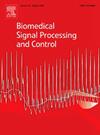CNN with double-side weighted visibility graph for automated classification of high-frequency oscillations in epilepsy
IF 4.9
2区 医学
Q1 ENGINEERING, BIOMEDICAL
引用次数: 0
Abstract
High-frequency oscillations (HFOs) in intracranial EEG are deemed clinically significant biomarkers for localization of epileptogenic focus. However, the identification of HFOs historically relies on visual observation which is laborious and invariably prone to inaccuracy. Here, we provided a new strategy that combines double-side weighted visibility graph (dWVG) and convolutional neural network (CNN) to automatically detect HFOs. The effectiveness of the proposed method was confirmed using stereotactic electroencephalography (SEEG) data recorded from 4 epilepsy patients, comprising 1880 HFO fragments and 1880 non-HFO fragments. In addition, the dWVG-based approach was also compared with other graph-based (i.e., time–frequency graph) methods. Results showed that the dWVG approach outperformed the time–frequency diagram and weighted visibility graph (WVG) with better classification accuracy a computing speed. By combining dWVG and CNN based on signal features instead of LeNet-like CNN, the best classification performance was obtained with an accuracy of 95.52%. These results indicate that the proposed approach plays a significant role in HFO classification, which may facilitate the localization of epileptogenic focus and provide more effective treatment for patients.
双面加权可见图CNN用于癫痫高频振荡的自动分类
颅内脑电图高频振荡(HFOs)被认为是癫痫灶定位的临床重要生物标志物。然而,hfo的识别历来依赖于目视观察,这是费力的,而且总是容易出错。本文提出了一种将双面加权可见性图(dWVG)和卷积神经网络(CNN)相结合的hfo自动检测策略。利用4例癫痫患者的立体定向脑电图(SEEG)数据,包括1880个HFO片段和1880个非HFO片段,证实了所提出方法的有效性。此外,还将基于dwvg的方法与其他基于图(即时频图)的方法进行了比较。结果表明,dWVG方法在分类精度和计算速度上优于时频图和加权可见性图(WVG)。将dWVG与基于信号特征的CNN相结合,而不是像lenet一样的CNN,获得了最好的分类性能,准确率达到95.52%。这些结果表明,该方法在HFO分类中具有重要作用,有助于癫痫灶的定位,为患者提供更有效的治疗。
本文章由计算机程序翻译,如有差异,请以英文原文为准。
求助全文
约1分钟内获得全文
求助全文
来源期刊

Biomedical Signal Processing and Control
工程技术-工程:生物医学
CiteScore
9.80
自引率
13.70%
发文量
822
审稿时长
4 months
期刊介绍:
Biomedical Signal Processing and Control aims to provide a cross-disciplinary international forum for the interchange of information on research in the measurement and analysis of signals and images in clinical medicine and the biological sciences. Emphasis is placed on contributions dealing with the practical, applications-led research on the use of methods and devices in clinical diagnosis, patient monitoring and management.
Biomedical Signal Processing and Control reflects the main areas in which these methods are being used and developed at the interface of both engineering and clinical science. The scope of the journal is defined to include relevant review papers, technical notes, short communications and letters. Tutorial papers and special issues will also be published.
 求助内容:
求助内容: 应助结果提醒方式:
应助结果提醒方式:


